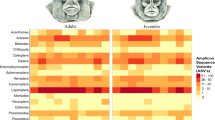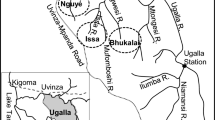Abstract
We studied food choices of black spider monkeys (Ateles paniscus) and red howlers (Alouatta seniculus) in an undisturbed tropical forest of French Guiana for 6 months in the rainy season. We made additional observations on tufted capuchins (Cebus apella) and examined the differences and similarities in feeding behavior with respect to the plant specific composition of the habitat and the biochemical characteristics of their food. Capuchins and spider monkeys mainly fed on ripe fruit pulp, to which they added invertebrates (capuchins) or young leaves (spider monkeys); their plant diet was more varied than that of howlers, which contained approximately equal proportions of ripe fruits and young leaves of many species, with large monthly variations in these food categories. BothAteles andAlouatta tended to feed preferentially on abundant plant species, with a large overlap in their fruit choices. The former species included a high proportion of soluble sugars and a low proportion of protein in its diet compared, to howlers. Leaves of several species selected byAlouatta reacted positively when screened for alkaloids and phenolic compounds. Besides specific metabolic requirements and adaptations to deriving nutrients from distinct food types, we hypothesize that the ability to taste sugars, which varies among primates, affects the range of foods appearing to be palatable and, consequently, contributes to the differentiation of feeding niches.
Similar content being viewed by others
References
Atramentowicz, M. (1988). La frugivorie opportuniste de trois marsupiaux didelphidés de Guyane.Rev. Ecol. (Terre Vie) 43: 47–57.
Barton, R. A., Whiten, A., Byrne, R. W., and English, M. (1993). Chemical composition of baboon plant foods: Implications for the interpretation of intra- and interspecific differences in diet.Folia Primatol. 61: 1–20.
Bonnaire, L., and Simmen, B. (1994). Taste perception of fructose solutions and diet in Lemuridae.Folia Primatol. 63: 171–176.
Bouquet, A. (1972). Plantes médicinales du Congo-Brazzaville,Uvariopsis, Pauridiantha, Diospyros, etc.,Travaux et Documents de l’ORSTOM, Vol. 13, ORSTOM, Paris.
Brand, J. G., Kare, M. R., and Nairn, M. (1980). Restraints in accepting new foods: Relationships among taste, acceptability, and digestion. In Pearson, P. B., and Greenwell, J. R. (eds.),Nutrition, Food and Man. An Interdisciplinary Perspective, University of Arizona Press, Tucson, pp. 105–123.
Braza, F., Alvarez, F., and Azcarate, T. (1983). Feeding habits of the red howler monkey (Alouatta seniculus) in the Llanos of Venezuela.Mammalia 47: 205–214.
CEGET-ORSTOM (1979).Atlas des départements franÇais d’Outre-Mer. La Guyane, IV, CNRS-ORSTOM, Paris.
Chapman, C. (1987). Flexibility in diets of three species of Costa Rican primates.Folia Primatol. 49: 90–105.
Estrada, A. (1984). Resource use by howler monkeys (Alouatta palliata) in the rain forest of Los Tuxtlas, Veracruz, Mexico.Int. J. Primatol. 5: 105–131.
Fleagle, J. G., and Mittermeier, R. A. (1980). Locomotor behavior, body size and comparative ecology of seven Surinam monkeys.Am. J. Phys. Anthropol. 52: 301–314.
Frankie, G. W., Baker, H. G., and Opler, P. A. (1974). Comparative phenological studies of trees in tropical wet and dry forests in the lowlands of Costa Rica.J. Ecol. 62: 881–919.
Freese, C. H., and Oppenheimer, J. R. (1981). The capuchin monkeys, genusCebus. In Coimbra-Filho, A. F., and Mitermeier, R. A. (eds.),Ecology and Behavior of Neotropical Primates, Vol. 1, Academia Brasileira de CiÊncias, Rio de Janeiro, pp. 331–390.
Gaulin, S. J. G., and Gaulin, C. K. (1982). Behavioral ecology ofAlouatta seniculus in Andean cloud forest.Int. J. Primatol. 3: 1–32.
Gautier-Hion, A., Gautier, J.-P., and Maiseis, F. (1993). Seed dispersal versus seed predation: An inter-site comparison of two related African monkeys. In Fleming, T. H., and Estrada, A. (eds.),Frugivory and Seed Dispersal: Ecological and Evolutionary Aspects, Kluwer Academic, Dordrecht, pp. 237–244.
Glander, K. E. (1978). Howling monkey feeding behavior and plant secondary compounds: A study of strategies. In Montgomery, G. G. (ed.),The Ecology of Arboreal Folivores, Smithsonian Institution Press, Washington, DC., pp. 561–574.
Glander, K. E. (1982). The impact of plant secondary compounds on primate feeding behavior.Yearbk. Phys. Anthropol 25: 1–18
Glaser, D. (1986). Geschmacksforschung bei Primaten.Vjschr. Naturf. Ges. Zürich 131(2): 92–110.
Grenand, P., Moretti, G., and Jacquemin, H. (1987).Pharmacopées Traditionnelles en Guyane, ORSTOM, Paris.
Guillotin, M., Dubost, G., and Sabatier, D. (1994). Food choice and food competition among the three major primate species of French Guiana.J. Zool. 233: 551–579.
Harborne, J. B., and Turner, B. L. (1984).Plant Chemosystematics, Academic Press, London.
Harrison, M. J. S., and Hladik, G M. (1986). Un primate granivore: Le colobe noir dans la forÊt du Gabon; Potentialité d’évolution du comportement alimentaire.Rev. Ecol. (Terre Vie) 41: 281–298.
Hladik, A. (1978). Phenology of leaf production in rain forest of Gabon: Distribution and composition of food for folivores. In Montgomery, G. G. (ed.),The Ecology of Arboreal Folivores, Smithsonian Institution Press, Washington, DC, pp. 51–71.
Hladik, A., and Hladik, C. M. (1969). Rapports trophiques entre végétation et primates dans la forÊt de Barro Colorado (Panama).Terre Vie 1: 25–117.
Hladik, A., and Hladik, C. M. (1977). Signification écologique des teneurs en alcaloÏdes des végétaux de la forÊt dense: Résultats des tests préliminaires effectués au Gabon.Terre Vie 31: 515–555.
Hladik, C. M. (1977). Field methods for processing food samples. In Clutton-Brock, T. H. (ed.),Primate Ecology: Studies of Feeding and Ranging Behaviour in Lemurs, Monkeys and Apes, Academic Press, London, New York, pp. 595–601.
Hladik, C. M. (1981). Diet and the evolution of feeding strategies among forest primates. In Harding, R. S. O., and Teleki, G. (eds.),Omnivorous Primates. Gathering and Hunting in Human Evolution, Columbia University Press, New York, pp. 215–254.
Hladik, C. M. (1988). Seasonal variations in food supply for wild primates. In Garine, I. D., and Harrison, G. A. (eds.),Coping with Uncertainty in Food Supply, Clarendon Press, Oxford, pp. 1–25.
Hladik, C. M., Hladik, A., Bousset, J., Valdebouze, P., Viroben, G., and Delort-Laval, J. (1971). Le régime alimentaire des primates de l’Île de Barro Colorado (Panama).Folia Primatol. 16: 85–122.
Howe, H. F. (1982). Fruit production and animal activity in two tropical trees. In Leigh, E. G., Rand, A. S., and Windsor, D. M. (eds.),The Ecology of a Tropical Forest. Seasonal Rhythms and hong-Term Changes, Smithsonian Institution Press, Washington, DC, pp. 189–199.
Izawa, K. (1975). Foods and feeding behavior of monkeys in the upper Amazon basin.Primates 16: 295–316.
Izawa, K. (1979). Foods and feeding behavior of wild black-capped capuchin (Cebus apella).Primates 20: 57–76.
Julliot, C. (1992).Utilisation des Ressources Alimentaires par le Singe Hurleur Roux, Alouatta seniculus(Atelidae, Primates), en Guyane: Impact de la Dissémination des Graines sur la Régénération Forestière, Thesis, University of Tours, Tours.
Julliot, C., and Sabatier, D. (1993). Diet of the red howler monkey (Alouatta seniculus) in French Guiana.Int. J. Primatol 14: 527–550.
Klein, L. L., and Klein, D. J. (1975). Social and ecological contrasts between four taxa of neotropical primates. In Tuttle, R. (ed.),Socioecology and Psychology of Primates, Mouton, The Hague, pp. 59–85.
Klein, L. L., and Klein, D. J. (1977). Feeding behaviour of the Colombian spider monkey. In Clutton-Brock, T. H. (ed.),Primate Ecology: Studies of Feeding and Ranging Behaviour in Lemurs, Monkeys and Apes, Academic Press, London, pp. 153–181.
Leigh, E. G. J., and Windsor, D. M. (1982). Forest production and regulation of primary consumers on Barro Colorado Island. In Leigh, E. G. J., Rand, A. S., and Windsor, D. M. (eds.),The Ecology of a Tropical Forest. Seasonal Rhythms and Long-Term Changes, Smithsonian Institution Press, Washington, DC, pp. 111–122.
Magnen, J. (1987). Central processing of sensory information in the control of feeding. In Otosson, D. (ed.),Progress in Sensory Physiology, Vol. 8, Springer-Verlag, Berlin, pp. 95–128.
Maiseis, F., Gautier-Hion, A., and Gautier, J. P. (1994). Diets of two sympatric colobines in Zaire: More evidence on seed-eating in forests on poor soils.Int. J. Primatol. 15: 681–701.
Marks, D. L., Swain, T., Goldstein, S., Richard, A., and Leighton, M. (1988). Chemical correlates of rhesus monkey food choice: The influence of hydrolyzable tannins.J. Chem. Ecol. 14: 213–235.
McKey, D., Waterman, P. G., Mbi, C. N., Gartlan, J. S., and Struhsaker, T. T. (1978). Phenolic content of vegetation in two African rain forests: Ecological implications.Science 202: 61–64.
Milton, K. (1979). Factors influencing leaf choice by howler monkeys: A test of some hypothesis of food selection by generalist herbivores.Am. Nat. 114: 362–378.
Milton, K. (1980).The Foraging Strategy of Howler Monkeys. A Study in Primate Economics, Columbia University Press, New York.
Milton, K., Soest, P. J., and Robertson, J. B. (1980). Digestive efficiencies of wild howler monkeys.Physiol. Zool. 53: 402–409.
Mittermeier, R. A., and Roosmalen, M. G. M. (1981). Preliminary observations on habitat utilization and diet in eight Surinam monkeys.Folia Primatol. 36: 1–39.
Pianka, E. R. (1973). The structure of lizard communities.Annu. Rev. Ecol. Syst. 4: 53–74.
Poney, O., Riéra, B., Larpin, D., Joly, A., Belbenoit, P., Jullien, M., Hoff, M., and Charles-Dominique, P. (1996). The permanent field research station “les Nouragues” in the tropical rain forest of French Guiana: Current projects and preliminary results on tree diversity, structure and dynamics. InProc. Int. Symp., Measuring and Monitoring Forest Diversity: A Network of Biodiversity Plots, Washington, DC, May 23–25, 1995 (in press).
Robbins, R. C., and Gavan, J. A. (1966). Utilization of energy and protein of a commercial diet by rhesus monkeys (Macaca mulatto).Lab. Anim. Care 16: 286.
Sabatier, D. (1985). Saisonnalité et déterminisme du pic de fructification en forÊt guyanaise.Rev. Ecol (Terre Vie). 40: 289–320.
Sabatier, D., and Prévost, M. F. (1990). Variations du peuplement forestier à l’échelle stationnelle: Le cas de la station des Nouragues en Guyane FranÇaise.Actes de l’Atelier MAB-UNESCO sur “l’aménagement et la conservation de l’écosystème forestier tropical humide,” pp. 169–187.
Simmen, B. (1991).Stratégies Alimentaires des Primates Néotropicaux en Fonction de la Perception des Produits de l’Environnement, Thesis, University Paris XIII, Villetaneuse.
Simmen, B. (1994). Taste discrimination and diet differentiation among New World primates. In Chivers, D. J., and Langer, P. (eds.),The Digestive System in Mammals: Food, Form and Function, Cambridge University Press, Cambridge, pp. 150–165.
Simmen, B., Hladik, C. M., and Martin, R. D. (1995). Sweet and bitter taste discrimination and energy requirements in nonhuman primates.Chem. Senses 20: 153 (abstract).
Struhsaker, T. T. (1975).The Red Colobus Monkey, University of Chicago Press, Chicago.
Symington, M. M. (1988a). Demography, ranging patterns, and activity budgets of black spider monkeys (Ateles paniscus chamek) in the Manu National Park, Peru.Am. J. Primatol. 15: 45–67.
Symington, M. M. (1988b). Food competition and foraging party size in the black spider monkey (Ateles paniscus chamek).Behaviour 105: 117–134.
Terborgh, J. (1983).Five New World Primates. A Study in Comparative Ecology, Princeton University Press, Princeton, NJ.
Roosmalen, M. G. M. (1980).Habitat Preference, Diet, Feeding Strategy and Social Organization of the Black Spider Monkey (Ateles paniscus paniscusLinnaeus 1758)in Surinam, Thesis, Agricultural University of Wageningen, Leersum.
Roosmalen, M. G. M., and Klein, L. L. (1988). The spider monkeys, genusAteles. In Mittermeier, R. A., Rylands, A. B., Coimbra-Filho, A., and Fonseca, G. A. B. (eds.),Ecology and Behaviour of Neotropical Primates, Vol. 2, World Wildlife Fund, Washington, DC, pp. 455–537.
Waterman, P. G., and Kool, K. M. (1994). Colobine food selection and plant chemistry. In Davies, A. G., and Oates, J. F. (eds.),Colobine Monkeys: Their Ecology, Behaviour and Evolution, Cambridge University Press, Cambridge, pp. 251–284.
Wheelwright, N. T., Haber, W. A., Murray, K. G., and Guindon, C. (1984). Tropical fruit-eating birds and their food plants: A survey of a Costa-Rican lower montane forest.Biotropica 16: 173–192.
Wisdom, C. S., Gonzalez-Coloma, A., and Rundel, P. W. (1987). Ecological tannin assays. Evaluation of proanthocyanidins, protein binding assays and protein precipitating potential.Oecologia 72: 395–401.
Zhang, S. Y. (1994).Utilisation de l’Espace, Stratégies Alimentaires et RÔle dans la Dissémination des Graines du Singe Capucin Cebus apella(Cebidae, Primate) en Guyane FranÇaise, Thesis, University Paris VI, Paris.
Zhang, S. Y. (1995). Activity and ranging patterns in relation to fruit utilization by brown capuchins (Cebus apella) in French Guiana.Int. J. Primatol. 16: 489–507.
Author information
Authors and Affiliations
Rights and permissions
About this article
Cite this article
Simmen, B., Sabatier, D. Diets of some French guianan primates: Food composition and food choices. Int J Primatol 17, 661–693 (1996). https://doi.org/10.1007/BF02735260
Received:
Accepted:
Issue Date:
DOI: https://doi.org/10.1007/BF02735260




